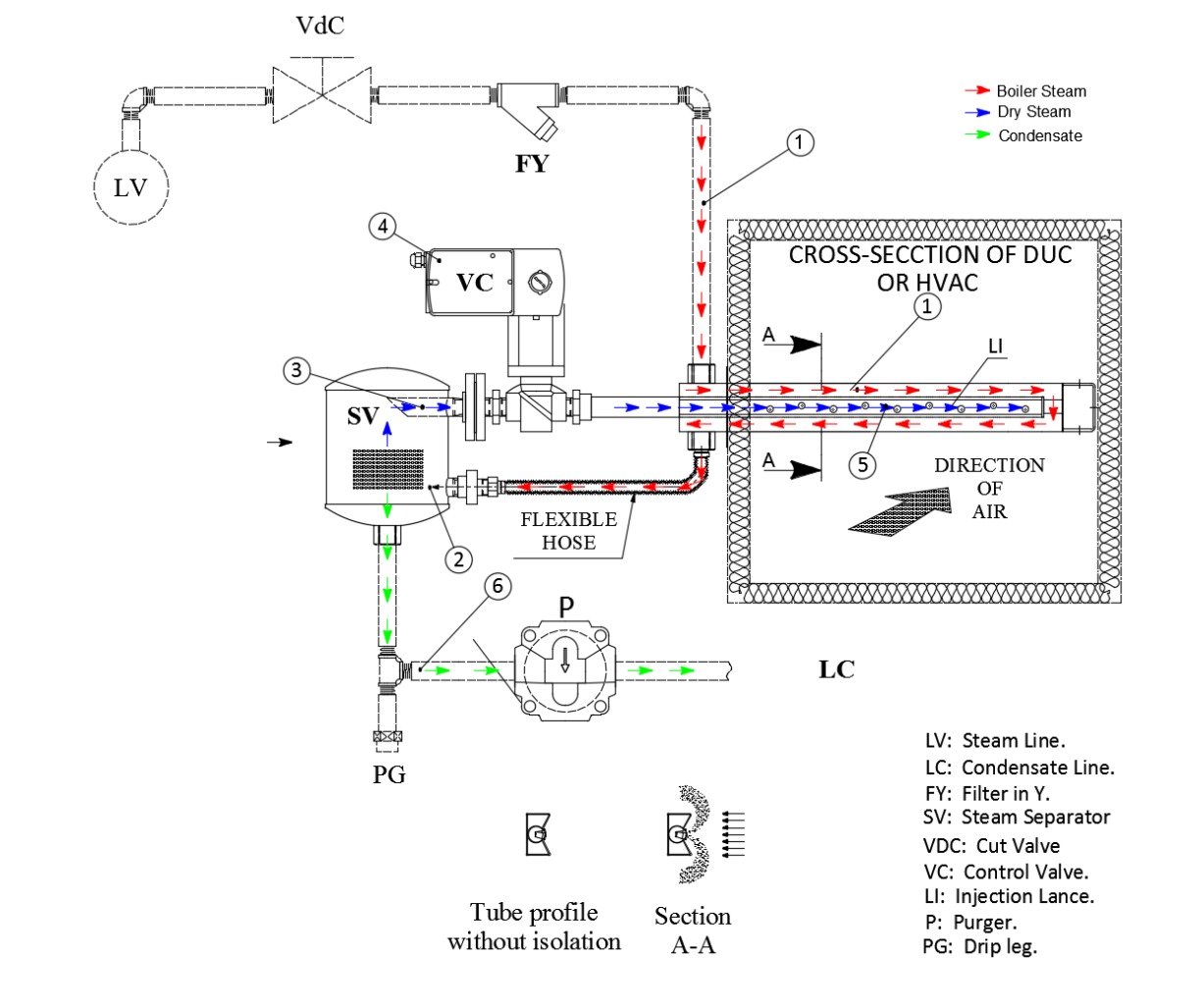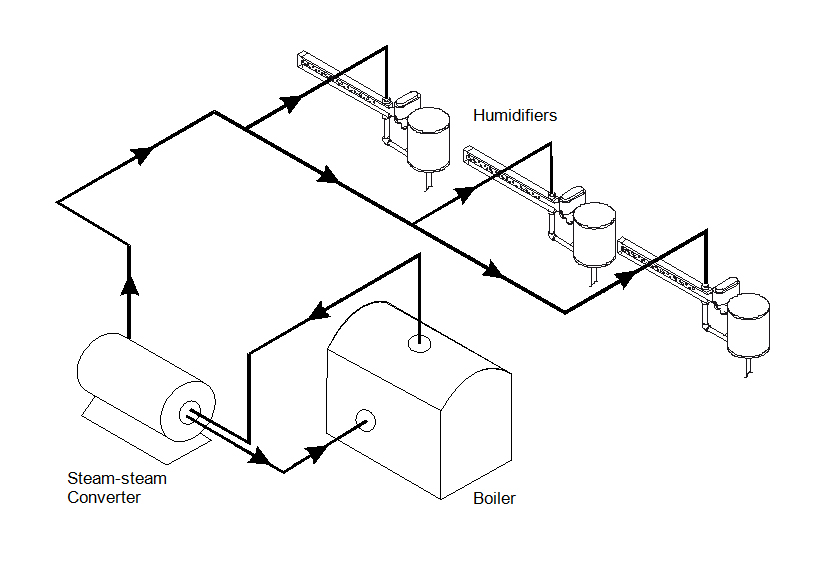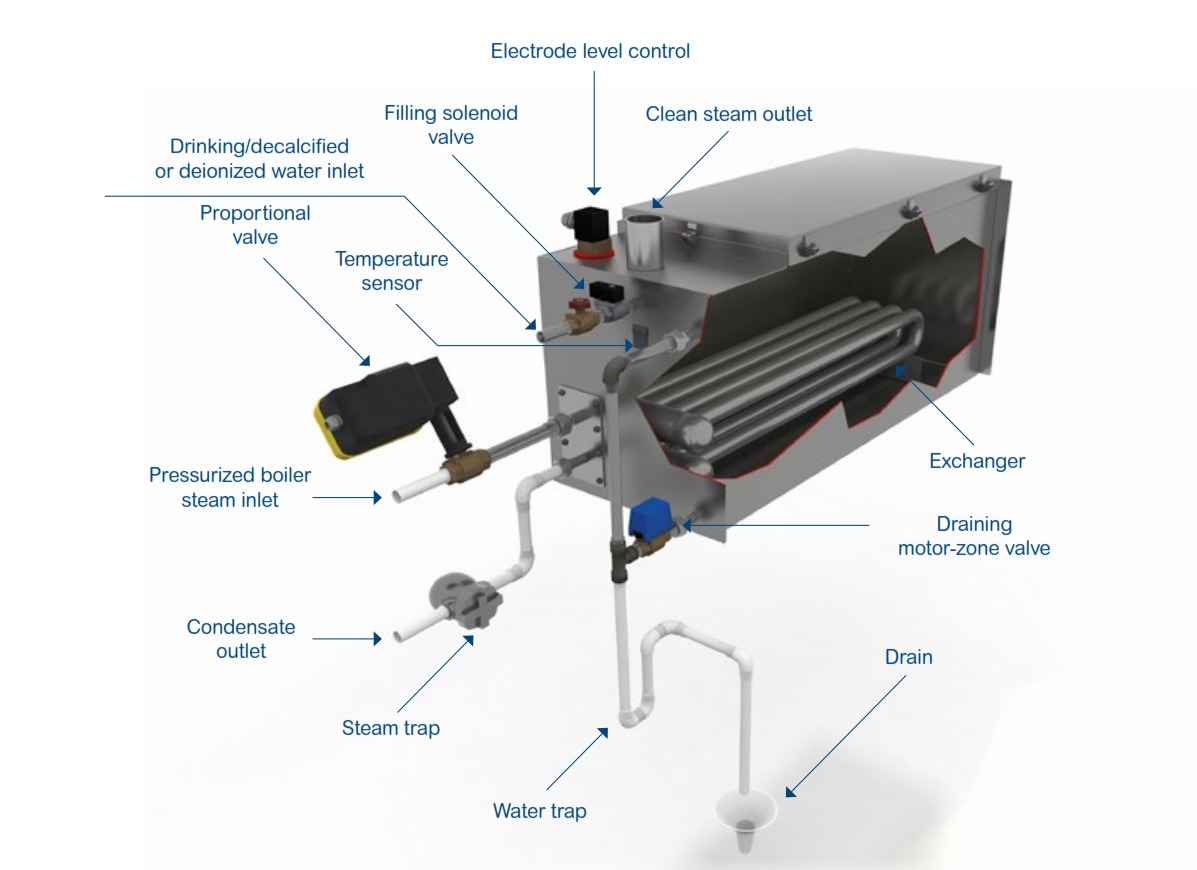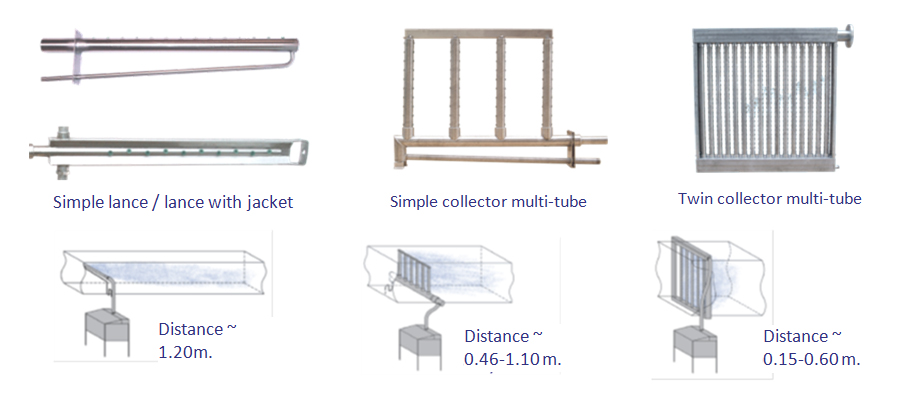
The generation and distribution of clean steam for HVAC installations in the pharmaceutical industry
For some time now, the expression “clean steam” has drawn the attention of technicians who have been using steam for a range of different purposes in the pharmaceutical industry. The terms is used to refer to it as a heat-conveying fluid or a source to provide specific humidity to the dry air flows in HVAC systems in pharmaceutical installations. The purpose of this article is to relate the importance of the steam’s quality for HVAC installations, the current regulations and the generating systems that are now at the cutting edge of air humidity control equipment design.
Boiler Water
HVAC technology is in many cases derived from technology applied to industrial processes. The feeding of water vapour, using air humidifiers to achieve a controlled relative humidity level in the human-occupied environment, began to increase in popularity in the early 1970s. This humidity control became increasingly important in Spain until the national regulation, issued by the Regulations on Heating Installations in Buildings of 1997, made the control of relative humidity in all public buildings mandatory. During the early years of air humidity control, the first configuration of the air humidifier was the one shown in figure 1. Systems to feed water vapour to dry air were firstly designed as a complement to centralized networks of boiler water designed for heating or industrial processes by means of humidifiers that treated part of that pressurised steam in order to be able to inject it into the primary air ducts in winter.. This kind of equipment has been in use for over forty years with very good precision, high durability and virtually zero maintenance.
These systems whose functional model is shown in figure 1 consist of a reducing valve to move the boiler steam at an adjustable pressure in HVAC systems (from 1 to 15 bars), a small Y-shaped filter to filter the steam from the network (1), one or more steam lances with a heating jacket (1) through which the pressurised steam flows to prevent condensation of the steam that we inject, a steam separator (2) which separates the liquid from the dry steam (3) by the centrifugal force that produces the spinning of the steam using a baffle, a steam intake in the centre of the separator, a control valve(4) that modulates the steam injection according to demand and restores the steam to almost atmospheric pressure. Finally, we have the steam lance or lances (depending on the load of the steam to the HVAC unit and the desired/calculated absorption distance) that injects the steam into the dry air via thermoplastic nozzles (5) calibrated to prevent condensation and noise. The steam is separated from the condensate (6) by means of a purger.
Sanitation quality steam/clean steam
Between the end of the last century and the beginning of this one, a number of health and hygiene studies found that the volatile organic compounds that penetrated iron piping for boiler steam to prevent them from corroding were harmful for human health. These studies determined that the amines used to protect the piping networks had a toxic effect on the health of users in buildings who breathed in the humidified air in the workplaces where this type of humidifier was in use.
There has been a change in the law since the problem was discovered. All boiler steam networks that are used for air humidifying must use sanitary quality steam (Spanish regulation RITE 2007 IT 1.1.4.3.3), that is to say, steam that comes from water of sanitary quality which is clearly regulated by Royal Decree 140/2003 which enacted the water quality for human consumption sanitary criteria. Of course, this excludes toxic compounds that protect the networks from corrosion. To prevent its contamination by rust as well as to prolong as much as possible the life of the installation, there is a choice between two systems to produce and distribute sanitary quality steam:
- A clean steam pressurized generator:
Clean steam free of chemical compounds is used in the pharmaceutical industry to prevent contact with this steam or its condensate from causing any contamination. The production of pressurized clean steam involves the use of specific generators with all of the components of the steam and condensate network (cut-off valves, regulation, reducers, filters, purgers, etc.) made of stainless steel of the highest quality. Clean steam of this quality, when it is pressurized, can easily cause piping network corrosion if they are not made of the highest quality materials and in addition, the steam itself may easily become contaminated if resistant materials are not used. When the steam is also used for air humidification all of the components of the humidifier must be made of the highest quality stainless steel. These systems are usually based on a boiler steam network and then a secondary boiler is added in the zone required that carries out the exchange with additive-free water to produce clean pressurized steam and distribute it through the required zones, injecting it in the ducts or HVAC units in the manner described above for the humidifiers using boiler steam injection but taking care that all of the components are made of the highest quality stainless steel. Depending on the use we make of the steam (if it is solely for use inside the HVAC installations or if it is also used for production processes, sterilizations or other applications in the pharmaceutical plant), sanitary grade steam can tolerate a water supply with an additional demineralization treatment by reverse osmosis, as required, in order to have water that is more or less clean. As we can see, the better the water quality, the higher the costs of producing, distributing and injecting it. In the diagram we can see the secondary boiler and the network of pressurized clean steam.
- Production of saturated dry clean steam and distribution without condensates:
If what is really important is the air conditioning of the air in the pharmaceutical plant, another option which is increasingly adopted by many large laboratories and hospitals, given the costs involved in the previous system, is to incorporate humidifiers that exchange boiler steam (which is unclean, with additives, in an economical closed circuit network) with sanitary grade or de-mineralized water if so required by the enclosed space or the precision of the system. This kind of equipment produces dry saturated steam under a level of pressure that is higher than that of the duct but very close to atmospheric and it is then conveyed to the ducts or HVAC units by steam distribution systems with virtually zero condensation. These systems produce steam by heating water and are able to handle everything related to the treatment of the water in their tank, controlling the use of boiler water according to the demand for humidification and also producing the right steam for the dry air flow to match it to a good dispersion of stream in the system.
Designing a good conduction of steam from the humidifier is essential in order to ensure that there are no major losses due to condensation. The location of the unit must be given careful consideration so that the conduction route is as short as possible. If it is not possible to design it with less than 3 metres, it is advisable to insulate the dry saturated steam duct using copper or stainless steel tubing. When it is less than three metres long, rubber tubing can be used that is reinforced for high temperatures and flex-resistant.
In addition to conducting the steam to the HVAC unit or air duct, it is essential to examine the dispersion of the clean steam in the dry air. If this is not done one may have condensations inside the air duct network. These condensations may be major foci of contamination. Deposits of water in places where they are not intended to occur as per the design are a source of undesirable health problems for air conditioning installations. In addition, and becoming more important every day, we find that these instances of condensation cause major energy losses in steam production and in water treatment plants. Producing steam requires 2326 kJ of energy per kilogram of steam that we need and treating the water so that it is optimal for humidification also consumes a lot of energy. If we do not minimize these condensations the energy cost of the installation can go off the scale.
To study the distance of steam absorption in the air, we must know several system parameters: flow and thermo-hygrometric conditions of the air before the steam is fed in, the amount of steam supplied and the dimensions of the wetting section of the AC unit or duct. Depending on all of these parameters and on the dispersion system chosen, we will have an absorption distance that may vary from 15 cm to over 2 metres. There are various steam dispersion systems depending on the needs involved as shown in the following illustration:
A controller that incorporates equipment of this type manages the steam production so that it accurately responds to the demand of the room or process. It also manages the water stored in the tank to keep it in perfect condition in terms of both quality and content of dissolved minerals. Finally, it manages to perfection the steam absorption in the dry air flow thereby preventing condensations that would otherwise cause large energy consumptions and sources of unintended health problems due to the production of clean steam in the previous system.
Conclusions:
The production of clean steam is in increasing demand in a host of pharmaceutical industries for a wide variety of applications. In the event of a need for this steam for productions processes (coming into contact with the product) whose water requires an extraordinarily high quality, it is possible that systems for the production and conveying of steam made with materials of the highest quality and at a high cost will be required.
For the case of processes where the steam is used for HVAC purposes and as a heat-carrying fluid for other processes, it has been demonstrated in practice already implemented in the industry that the global solution may call for replacing boiler steam with sanitary grade water. These systems used in conjunction with appropriate steam dispersion systems offer a guarantee of sufficient quality steam and, unlike the other system, a safeguard in terms of the possible condensations in air ducts.
Bibliography:
- HARRIMAN, Lew; BRUNDRETT, Geoff; KITTLER, Reinhold: “Humidity control design guide”. Atlanta, EEUU. 2006. Editorial ASHRAE.
- LATHAM, Tim: “Clean steam in the pharmaceutical industry”. PDH Course K109. PDH Online center. EEUU. 2004
- RITE y normas UNE de aplicación. Barcelona. Editorial CEYSA
- Real Decreto 1027/2007, de 20 de julio, por el que se aprueba el reglamento de instalaciones térmicas en los edificios.
- MORTON, B. W: “Humidification Handbook”. 1998. Ed. DriSteem.













Leave a reply